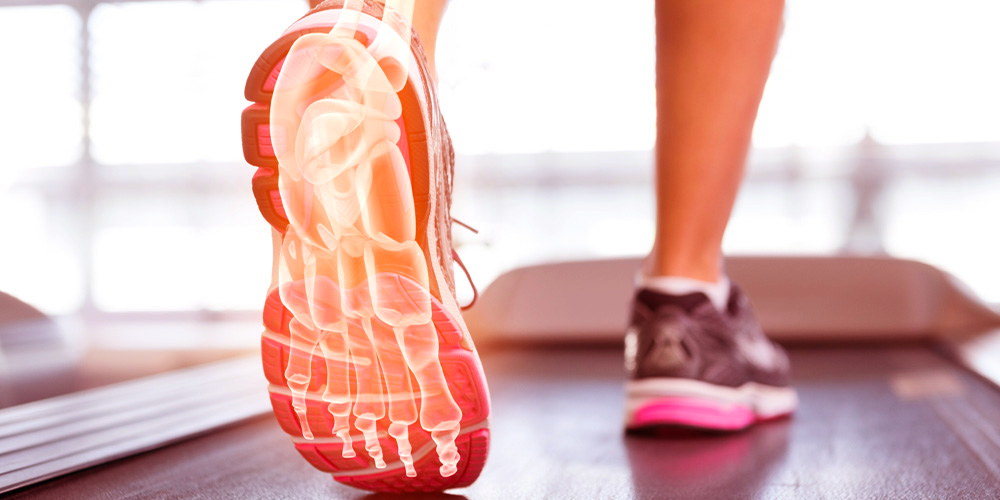If pronation is excessive, you run the risk of experiencing pain in your feet, knees or spine. You can prevent this problem with the right shoes.

Author: Michel Züger, qualified physiotherapist FH, sports physiotherapist SPT, MAS Health Service Management, Head of Therapies and Complementary Medicine, Medbase St. Gallen Einstein
What is pronation?
Depending on how the foot is placed in relation to the leg axis, we speak of pronation or supination. In pronation, the foot sinks more on the inside than on the outside, it “bends” inwards, so to speak. With supination, it is the opposite.
It is normal for the foot to bend slightly inwards when it hits the ground and rolls off again, and this helps to absorb shock. With pronators, however, the foot “tilts” even more inwards, so that both the inside of the heel and the inside edge of the foot are subjected to more stress than the outside edge every time the foot rolls. This is also called “overpronation”.
How does overpronation occur?
Overpronation, i.e. increased pronation, occurs when the foot has too little natural muscle tension. Normally, every foot has a longitudinal and a transverse arch – but this requires good foot muscles. Unfortunately, we often forget to train these muscles. Everyday walking in shoes on hard floors does the rest – the foot muscles slacken and the arch of the foot flattens.
What are the consequences of overpronation?
Often it leads to curved flat feet, which can cause irritation of the fascia on the sole of the foot (plantar fascia), irritation of the Achilles tendon, knee pain and even pain up into the spine.
Underpronation
Supinators tend to “tilt” their foot outwards, they put more weight on the outer edge of their foot. Their footprint in the sand therefore looks more crescent-shaped. Supinators have “underpronation”, so they need shoes that are more supported on the outside.
Many footballers are supinators. Typically, they have a hollow foot with an excessively high arch. Their feet have (too) much tension. Then it is important for them to do exercises to reduce this tension, for example, “rolling out” the foot over a ball and stretching the calves.
Which exercises help with overpronation?
Run barefoot! Nothing trains your foot as well as walking or running barefoot on a variety of surfaces. Run on different surfaces. Your foot will get completely different input on a finnish track, on a meadow or on a forest path.
Exercises such as walking on toes, standing on toes, picking up small balls or cloths with your toes can straighten the longitudinal and transverse arches. Customised shoe inserts can also support the foot. Changing your running style to put a different load on your feet is very difficult and takes a long time. If you change your running style too suddenly, this usually leads to overloads, for example on the Achilles tendon.
Training advice at Medbase
The sports scientists and sports physicians at Medbase check your performance level with an endurance test. Based on this, they explain to you in a clear and uncomplicated way how you can optimally design and dose your training.
Book now
How can you tell if you tend to overpronate?
Your old running shoes can also give you a clue: if they are worn on the inside edge, you probably tend to overpronate. In the case of severe pronation, the entire shoe is compressed and pushed inwards in the heel area. But the best way to see it is to run barefoot in the sand: If your footprint is very flat and especially the longitudinal arch is flattened, then you belong to the “pronators”. Most runners belong to this group.
What role do running shoes play?
The right shoes are crucial to prevent overloading the musculoskeletal system. If the basis, i.e. the shoe, is not right, you can train and do as much as you want at the top – sooner or later you will have problems with your musculoskeletal system. A shoe for pronators has more support on the inner side of the foot, one for supinators on the outer side.
What should you keep in mind when buying shoes?
Just slipping them on and walking up and down a few times is not enough. Even if the shoes feel very comfortable, that doesn’t tell you whether they are really suitable for your foot. The colour of the shoe and how it looks on your foot is also irrelevant – for the sake of your body.
It is best to have a stance analysis and a running analysis done at a specialised shop. A salesperson with a trained eye is very useful. The stance analysis measures the pressure distribution in the sole of the foot. A running analysis with video is also recommended. Be sure to test the shoes in running mode! This is because much greater forces act on the foot when running.
What role does overpronation play when cycling?
When cycling, pronation is not as important as when running because the foot is fixed on the pedal. You can correct it with the help of a shoe insert and clipless pedal plates.
TIPS
- Bike fitting is extremely important. It is worth investing some money in this. Then you’ll know whether the line of your knee is exactly over the pedal or whether it deviates inwards or outwards during certain pedalling phases and how much pressure is exerted on the pedals.
- You can get a lot out of cycling by changing your position on the bike depending on the terrain (uphill, downhill).
- If your feet get cramped when cycling or if you get a numb feeling, have your riding position and angle checked.
Who is Medbase?
Medbase is the largest multidisciplinary sports medicine network in Switzerland and provides specialised sports medicine services to athletes, clubs and sports federations of all activity levels in the areas of sports medicine, sports physiotherapy, performance diagnostics and training advice.

